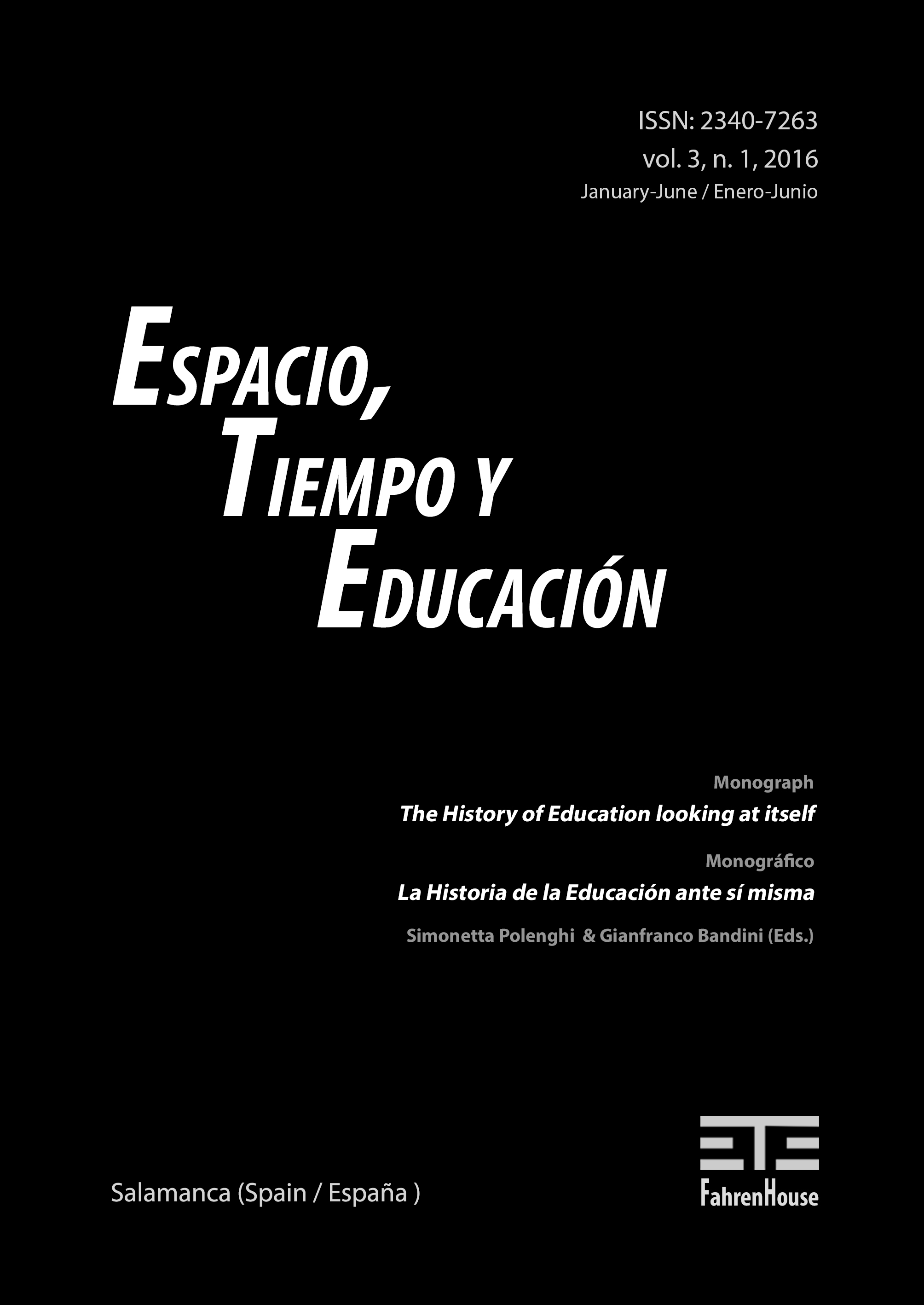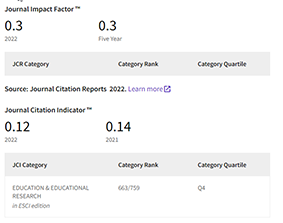Percy MacKaye’s Civic Theatre: a Pioneer in Theatre Animation and the Pedagogy of Leisure
DOI:
https://doi.org/10.14516/ete.2016.003.001.20Parole chiave:
progressivism, civic theatre, community theatre, theatre education, cultural democracy, constructive leisureAbstract
In the first two decades of the 20th century the career of Percy MacKaye becomes especially relevant. As a brilliant American scholar and playwright, he formulated a plan for the organization of the theatre that aimed at promoting the social, cultural and educational potential of a theatrical praxis based on the active participation of people, linked to community development. In this paper, born of a critical reading of his theoretical work, we show how the educational, cultural and artistic uses of theatrical practice promoting a constructive leisure, have in MacKaye’s essays a precedent on theoretical and practical grounds. His proposals are still relevant considering today’s challenges, among which it stands out the creation of spaces for meeting and interaction where the community may meet, recognize and recreate itself. His essays become even more significant considering old problems such as the «arrangement of the theatres» and the status of theater education, formulated by enlightened thinkers such as Jovellanos or Moratín, which two centuries later still await an appropriate solution. We close the paper with a set of conclusions where specific proposals concerning those old issues are made.
Riferimenti bibliografici
Addams, J. (1910). The Spirit of Youth and the City Streets. New York: Macmillan.
Addams, J. (1911). Twenty Years at Hull House with Autobiographical Notes. New York: Macmillan.
ADE. (2007). Bases para un Proyecto de Ley del Teatro. Madrid: ADE. Recuperado de http://www.adeteatro.com/
ADT. (2008). Una Ley de Artes Escénicas para España. Madrid: Editorial Círculo Rojo.
Anderson, W. G. (1973). Progressivism: An Historiographical Essay. The History Teacher, 6(3), 427-452.
Andioc, R. (2013). De la comedia nueva a la reforma del teatro. Cuadernos de Ilustración y Romanticismo, 19, 7-25.
Bancroft, J. H. (1909). Games for the Playgroud, Home, School and Gymnasium. New York: Macmillan.
Bates, E. W. (1912). Pageants and Pageantry. Boston: Gin and Company.
Beegle, M. P., & Crawford, J. R. (1916). Community Drama and Pageantry. New Haven: Yale University Press.
Berkowitz, G. M. (1997). New Broadways. Theatre Across America: Approaching a New Millenium. New York: Applause.
Blair, K. J. (1990). Pageantry for Women’s Rights: The Career of Hazel MacKaye, 1913-1923. Theatre Survey, 31(1), 23-46.
Bolton, G. (1984). Drama as education. London: Longman.
Bourdieu, P. (1988). La distinción. Criterios y bases sociales del gusto. Madrid: Taurus.
Burleigh, L. (1917). The Community Theatre in Theory and Practice. Boston: Little, Brown and Company.
Burke, K. (1945). A grammar of motives. New York: Prentice Hall.
Butsch, R. (1990). Introduction: Leisure and Hegemony in America. In Butsch, R. (Ed.), For Fun and Profit: The Transformation of Leisure Into Consumption (pp. 3-27). Philadelphia: Temple University Press.
Caride, J. A. (2012). Lo que el tiempo educa: el ocio como construcción pedagógica y social. Arbor, 754, 301-303.
Caride, J. A., & Meira, P. (2000). La Educación Social en las Políticas Culturales: hacia una construcción pedagógica de la democracia cultural. In Caride, J. A. (Coord.), Educación social y políticas culturales (pp. 19-42). Santiago de Compostela: Tórculo.
Caride, J. A., & Vieites, M. F. (Eds.). (2006). De la educación social a la animación teatral. Gijón: Trea.
Carlson, M. (2003). Performance. A Critical Introduction (2nd. Edition). New York: Routledge.
Courtney, R. (1989). Play, Drama & Thought. The Intellectual Background of Dramatic Education. Toronto: Simon & Pierre.
Craig, A. T. (1912). The Dramatic Festival. New York: G. P. Putnam’s Sons.
Cuenca Cabeza, M. (2004). Pedagogía del Ocio: Modelos y Propuestas. Bilbao: Universidad de Deusto.
Curtis, E. W. (1914). The Dramatic Instinct in Education. Boston: Houghton Mifflin.
Davis, M. M. (1911). The exploitation of pleasure. A study of commercial recreations in New York. New York: Russell Sage Foundation.
Davol, R. (1914). American Pageantry. Tauton: Davol Publishing Company.
De Micheli, M. (2002). Las vanguardias artísticas del siglo XX. Madrid: Alianza.
Dickinson, Thomas H. (1925). Playwrights of the New American Theatre. New York: Macmillan.
Dobson, M. (2010). The Pageant of History: Nostalgia, the Tudors, and the Community Play. SEDERI Yearbook, 20, 5-25.
Ealy, L. T., & Ealy, S. D. (2006). Progressivism and Philanthropy. The Good Society, 15(1), 35-42.
Elkonin, D. B. (1985). Psicología del juego. Madrid: Visor.
Esterri, N. (2004). El teatro social. Educación social. Revista Interuniversitaria de intervención socioeducativa, 28, 67-82.
Faulkner, H. U. (1931). The Quest for Social Justice, 1898-1914. New York: Macmillan.
Finnegan, M. (1999). Selling Suffrage: Consumer Culture and Votes for Women. New York: Columbia University Press.
Frick, J. (1999). A Changing Theatre. In Wilmeth, D. B., & Bigsby, Ch. (Eds.), The Cambridge History of American Drama. Volume Two: 1870-1945 (pp. 196-232). Cambridge: Cambridge University Press.
Froebel, F. (1885). The Education of Man. New York: A Lovell and Company.
Fry, E. S. (1913). Educational Dramatics. A Handbook on the Educational Player Method. New York: Moffat, Yard and Company.
Gendzel, G. (2011). What the Progressives Had in Common. Journal of the Gilded Age and Progressive Era, 19, 331-339.
Glassberg, D. (1990). American Historical Pageantry: The Uses of Tradition in the Early Twentieth Century. Chapel Hill: North Carolina University Press.
Goffman, E. (1959). The Presentation of Self in Everyday Life. New York: Anchor Books.
Gourdon, A-M. (Ed.). (1986). Animation, Théâtre, Societé. Paris: Éditions du CNRS.
Groos, K. (1901). The Play of Man. London: Heinemann.
Harris, J. W. (1992). Medieval Theatre in Context. London: Routledge.
Herts, A. M. (1911). The Children’s Educational Theatre. New York: Harper & Brothers.
Hilliard, E., McCormick, T., & Oglebay, K. (1917). Amateur and Educational Drama. New York: The Macmillan Company.
Horkheimer, M., & Adorno, Th. W. (2003). Dialéctica de la Ilustración. Edición de Juan José Sánchez. Madrid: Trotta.
James, W. (1905). The Principles of Psychology, II. New York: Henry Holt and Company.
Jor, F. (1979). La desmitificación de la cultura. Madrid: Ministerio de Cultura.
Lee, J. (1915). Play in Education. New York: Macmillan.
Leif, J. (1992). Tiempo libre y tiempo para uno mismo. Un reto educativo y cultural. Madrid: Narcea.
Lynch, F. R. (1977). Social Theory and the Progressive Era. Theory and Society, 4(2), 159-210.
MacKaye, P. (1909). The Playhouse and the Play. New York: Macmillan.
MacKaye, P. (1912). The Civic Theatre in Relation to the Redemption of Leisure. A Book of Suggestions. New York: Mitchell Kennerley.
MacKaye, P. (1914). Sanctuary. A Bird Masque. New York: Frederick A. Stokes Company.
MacKaye, P. (1915). A Substitute for War. New York: Macmillan.
MacKaye, P. (1916). Caliban by the Yellow Sands. A Community Masque of the Art of the Theatre. New York: Doubleday, Page & Company.
MacKaye, P. (1917). Community Drama. Boston: Houghton Mifflin.
MacKaye, P. (2015). Por un teatro cívico. Edición de Manuel F. Vieites. Madrid: Asociación de Directores de Escena de España.
MacKaye Ege, A. (1992). The Power of the Impossible. The Life Story of Percy & Marion MacKaye. Falmouth: The Kennebec River Press.
Mehler, M. P. (2010). Percy MacKaye: Spatial Formations of a National Character. (Tesis doctoral). University of Pittsburgh. Recuperado de http://d-scholarship.pitt.edu/6567/
Mendelsohn, M. J. (1970). Percy MacKaye’s Dramatic Theories. The Bulletin of the Rocky Mountain Modern Language Association, 24(2), 85-89.
Nochlin, L. (1985). The Paterson Strike Pageant of 1913. In McConachie, B. A., & Friedman, D. (Eds.), Theatre for Working-Class Audiences in the United States, 1830-1980 (pp. 87-95). Westport: Greenwood Press.
Ortega y Gasset, J. (1989). Una interpretación de la historia universal. Madrid: Alianza & Revista de Occidente.
Pose, H. (2006). La ciudad creadora. ADE/Teatro, 118, 35-44.
Pose, H. (2007). La cultura en las ciudades: un quehacer cívico-social. Barcelona: Graó.
Prevots, N. (1990). American Pageantry: A Movement for Art and Democracy. Ann Arbor: University of Michigan Press.
Reese, W. J. (2001). The Origins of Progressive Education. History of Education Quarterly, 41(1), 1-24.
Rehm, M. A. (2011). The Art of Citizenship: Suffrage Literature as Social Pedagogy. Tesis doctoral defendida en University of Pittsburgh. Recuperado de http://d-scholarship.pitt.edu/7535/
Rolland, R. (1903). Le théâtre du peuple. Paris: Cahiers de la Quizaine.
Rousseau, J.-J. (1994). Carta a D’Alembert sobre los espectáculos. Madrid: Tecnos.
Rubio Jiménez, J. (1998). El conde de Aranda y el teatro. Zaragoza: IberCaja.
Ruiz, G. (2013). La teoría de la experiencia de John Dewey: significación histórica y vigencia en el debate teórico contemporáneo. Foro de Educación, 15, 103-124.
Ruyter, N. L. Ch. (2012): A Influência do Trabalho de Delsarte nos Estados Unidos a partir do Final do Século XIX. Revista Brasileira de Estudos da Presença, 2(2), 457-469.
Sáez Carreras, J., & Molina, J. G. (2006). Pedagogía Social. Pensar la Educación social como profesión. Madrid: Alianza.
Sizer, J. P. (1917). The Commercialization of Leisure. Boston: The Gorham Press.
Spencer, H. (1873). The Principles of Psychology. New York: Appleton.
Spiller, R. E. (Ed.) (1975). Literary History of the United States. New York: Macmillan.
Spring, J. (1970). Education and Progressivism. History of Education Quarterly, 10(1), 53-71.
Taft, L. (1921). The Technique of Pageantry. New York: A. S. Barnes and Company.
Trilla, J. (Coord.). (1997). Animación sociocultural. Teorías, programas y ámbitos. Barcelona: Ariel.
Trilla, J. (1997). Concepto, discurso y universo de la animación sociocultural. In Trilla, J. (Coord.), Animación sociocultural. Teorías, programas y ámbitos (pp. 13-39). Barcelona: Ariel.
Trilla, J. (1999). Animación sociocultural y educación en el tiempo libre. In Petrus, A. (Coord.), Pedagogía social (pp. 130-153). Barcelona: Ariel.
Úcar, X. (1992). El teatro en la animación sociocultural. Técnicas de intervención. Zaragoza: Diagrama.
Vaquer, M. (1998). Estado y cultura: la función cultural de los poderes públicos en la Constitución Española. Madrid: Fundación Ramón Areces y Universidad Carlos III.
Vieites, M. F. (2013). La construcción de la pedagogía teatral como disciplina científica. Revista Española de Pedagogía, 256, 493-508.
Vieites, M. F. (2014). Educación teatral: una propuesta de sistematización. Teoría de la educación, 26(1), 77-101.
Vilar, J. (1975). Le Théâtre: service publique. Paris: Gallimard.
Ward, W. (1930). Creative Dramatics. New York: Appleton.
Witham, B. B. (2003). The Federal Theatre Project. A Case Study. Cambridge: Cambridge University Press.
Withington, R. (1912). A Manual of Pageantry. Bloomington: Indiana University.
Withington, R. (1918). English Pageantry. An Historical Outline, Volume I. Cambridge: Harvard University Press.
Withington, R. (1920). English Pageantry. An Historical Outline, Volume II. Cambridge: Harvard University Press.
Whibley, C. (1900). The Pageantry of Life. New York: Harper & Brothers.
Wood, W. (Ed.) (1913). The Playground Movement in America and its Relation to Public Education. London: Board of Education.







